American Empire Period
During the War of 1812, America’s enemy, England, was also at war with Napoleonic France. America’s political sympathies with Napoleon fueled an interest in French fashion modeled on the archeology of Imperial Rome. Many Americans demonstrated their own political outlook by purchasing the highly decorative Napoleonic, or Empire, fashions from craftspeople in American cities, such as Philadelphia, Baltimore, and New York. Delaware craftspeople supplied very little of this cosmopolitan, deeply carved, erudite style. Instead, they perpetuated the simpler, more practical Federal style well into the 1800s. Meanwhile, the Empire effect on portraits during this time demonstrated a growing romanticism, marked by more-expressive brushstrokes, poses and colors.
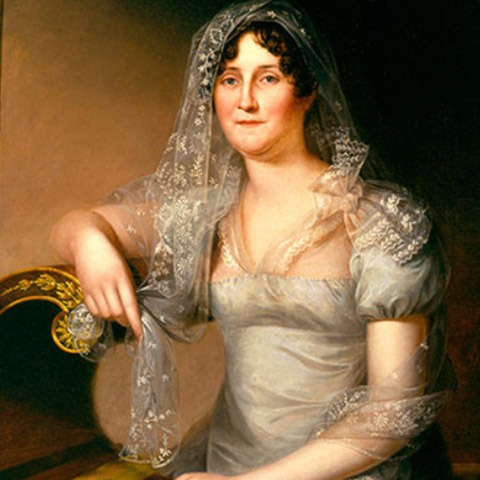
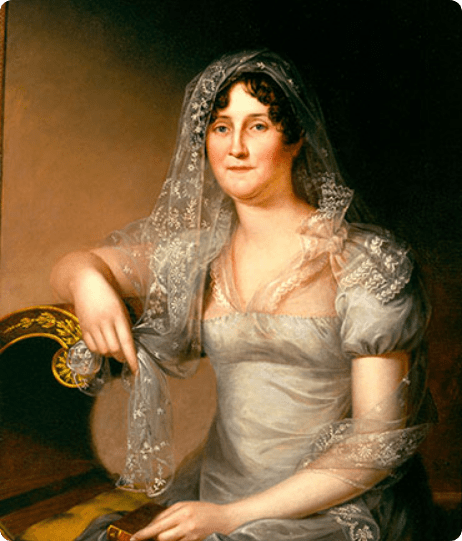
Portraits of women from this period reveal the extent to which Napoleon’s style pervaded American fashion, with many women modeling their appearance after marble Greek and Roman statues. Fashionable dress turned to sheer fabrics, body-conforming drapery, and the characteristic high, or Empire, waist silhouette.
MARGARETTA ANN RYAN
(MRS. JOHN WALLACE THOMPSON)
JAMES PEALE (1749–1831)
1817
OIL ON CANVAS
SEWELL C. BIGGS BEQUEST; 2004.440


Members of the country’s military were eager to memorialize the heroics of the Revolutionary War and the War of 1812, so they simply commissioned their own portraits. Patriotic fervor is demonstrated by the illusion of the officer’s wind-tussled hair and gleaming decoration of his uniform, created by a freer brush stroke and less precise application of paint on the canvas.
LIEUTENANT JOHN MONTGOMERY DALE
THOMAS SULLY (1783–1872)
1818
OIL ON CANVAS
SEWELL C. BIGGS BEQUEST; 2004.429


In addition to artists who painted portraits, a growing group of U.S. painters were eager to start an American school of art and explore new methods of painting. James Peale and his nephew Raphael Peale (1784–1825) established the first school of still-life paintings in the United States. Although considered one of the lowest forms of painting in the European tradition, still life became a new means of artistic expression in America.
STILL LIFE WITH BROKEN WATERMELON
JAMES PEALE (1749–1831)
1825
OIL ON PANEL
SEWELL C. BIGGS BEQUEST; 2004.439


Ever since Congress adopted the bald eagle as the country’s national symbol in 1782, eagle decorations and sculptures (pictured) have been carved in America and Europe for American consumers. Measuring 47 inches wide, this large sculpture may have been part of a matching pair and was probably carved to decorate a civic building.
EAGLE
CARVER UNKNOWN
ENGLAND OR UNITED STATES, CA. 1820–50
ELM
SEWELL C. BIGGS BEQUEST; 2004.494
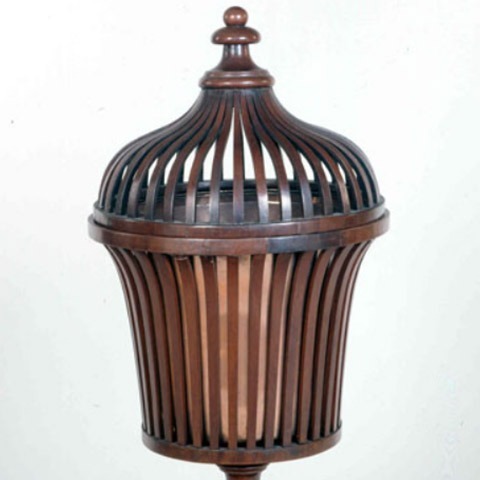
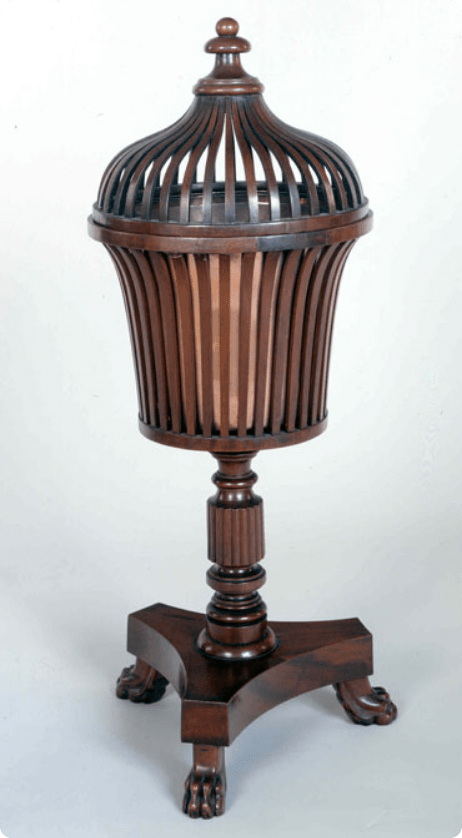
Rare pieces like this wine cooler represent the range of specialized furniture forms available to early Americans for dining and entertaining. Meanwhile, the luxury of wine consumption at this time indicates of a significant growth in the American upper classes.
WINE COOLER, 1810-30
MAKER UNKNOWN
PROBABLY PHILADELPHIA
MAHOGANY, MAHOGANY VENEER, TULIP POPLAR
GIFT OF SEWELL C. BIGGS; 1992.104

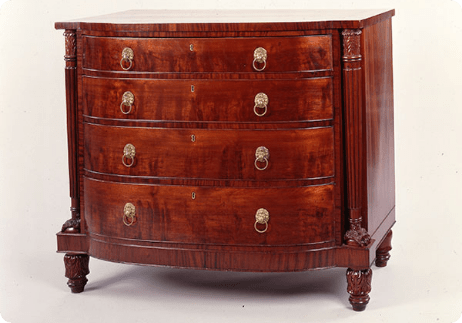
Philadelphia cabinetmakers like Joseph Barry were heavily influenced by Collection of Designs for Household Furniture and Interior Decoration (1808), a book on furniture design by George Smith. This London designer instructed Americans about the European fashion for furniture forms inspired by recent archeological excavations in Italy.
CHEST OF DRAWERS
POSSIBLY JOSEPH B. BARRY (1760–1838)
PHILADELPHIA, 1810–20
MAHOGANY, MAHOGANY VENEER, TULIP
POPLAR, WHITE PINE
GIFT OF SEWELL C. BIGGS; 1992.74
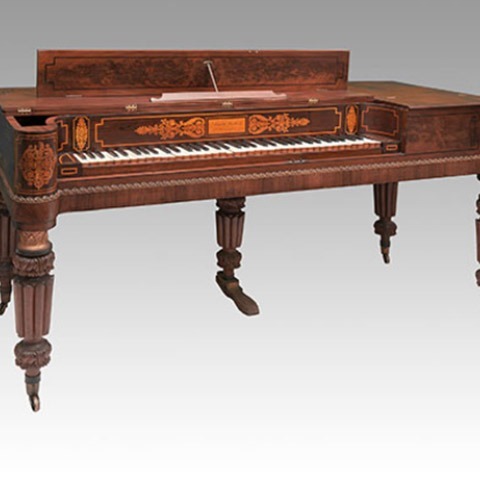
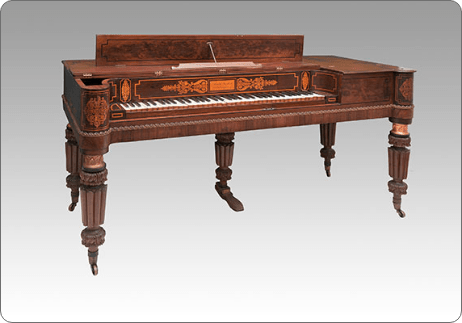
American-made pianos represent the country’s independence from England with the production of both luxury and household goods. At the same time, local production of such costly instruments indicates the growth of American leisure and overall financial health in the early 1800s.
PIANOFORTE
LOUD & BROTHERS (WORKING CA. 1822–1833)
PHILADELPHIA, 1830
MAHOGANY, ROSEWOOD, MAPLE, WHITE PINE
GIFT OF SEWELL C. BIGGS; 1992.87

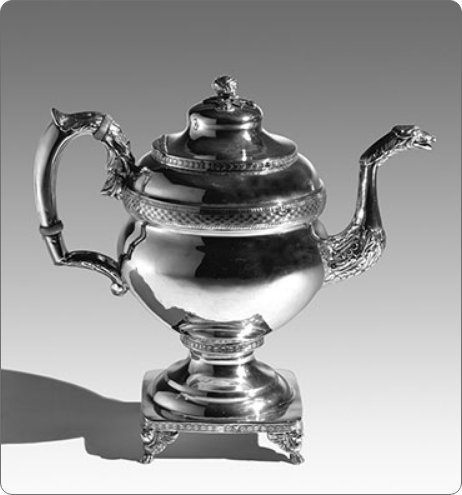
Thomas Whartenby was born in Duck Creek (now Smyrna), Delaware, and entered into an apprenticeship with Samuel Richards Jr., a silversmith working in Philadelphia. Whartenby produced French Empire-inspired silver wares with Peter Bumm in Philadelphia for a short time after the War of 1812.
TEAPOT, CA. 1816
WHARTENBY & BUMM (WORKING CA. 1816–1818)
PHILADELPHIA
SILVER
GIFT OF SEWELL C. BIGGS; 1994.47


This presentation sword, one of five identical examples known to exist, was created as a result of the partnership between General James Wolf, Wilmington maker of the silver eagle handle, and Joseph Rose, Philadelphia maker of the steel blade.
SWORD AND SCABBARD, CA. 1812
GENERAL JAMES WOLF (1779-1858)
WILMINGTON
SILVER, STEEL, LEATHER
PARTIAL GIFT OF COL. KENNETH P. AND REGINA I. BROWN; 2005.419

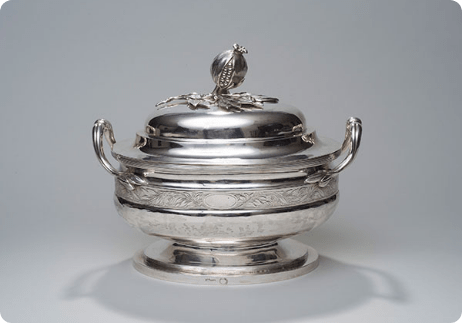
Due to their value and portability, silver objects were often the first decorative arts in America to reflect the latest European fashions. Not only does this tureen foreshadow the Empire style in America, it also demonstrates new technologies for working with metal. Traditionally, silversmiths formed silver objects from a nugget, laboriously hammering the metal into the desired shape. Many silversmiths of this period began investing in quantities of industrially produced rolled silver sheets to hasten the speed of production.
COVERED TUREEN AND TRAY
JOSEPH LOWNES (1754–1820)
PHILADELPHIA, CA. 1810
SILVER
GIFT OF SEWELL C. BIGGS; 1993.35.1–.3
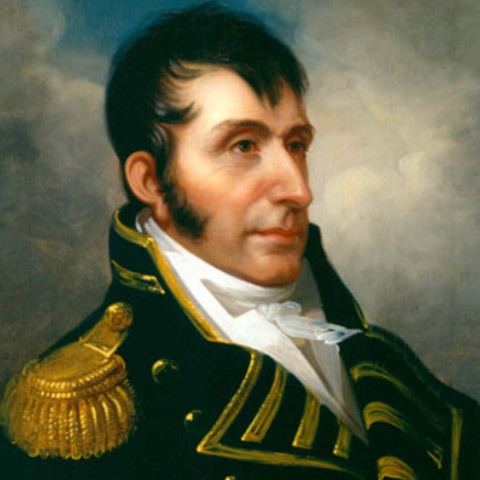
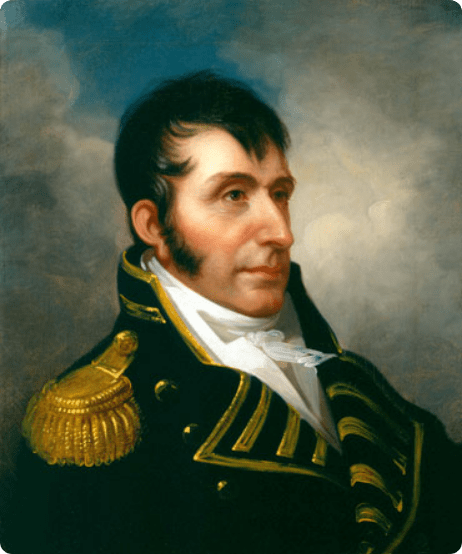
Commodore Jacob Jones, a native of Smyrna, Delaware, was a widely heralded hero of the War of 1812. The work follows closely in line with Rembrandt Peale’s other representations of American war heroes, which often featured evocative clouds in the background and dashingly windswept hair styles. The work provides an example of the ways in which American citizens and American painters integrated Napoleonic fashions and European Romantic artistic styles into their lives, in keeping with their French sympathies during this era.
FOR FURTHER THINKING: What aspects of the painting do you think suggest Commodore Jones’ heroism?
How is this portrayal similar or different to how we portray war heroes and heroic people today?
COMMODORE JACOB JONES, USN
REMBRANDT PEALE (1778-1860)
CA. 1813-14
OIL ON CANVAS
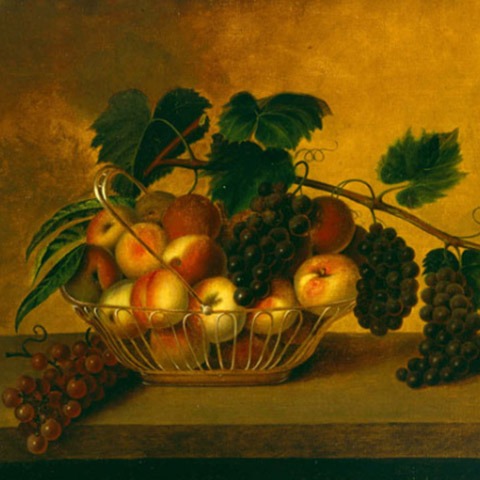
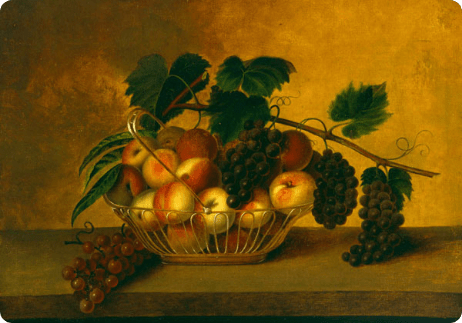
Rubens Peale came from a family of prolific artists from the Philadelphia area. He began his work as an artist late in life, after time as a museum manager, farmer, and, most fervently, a naturalist. To reference that latter passion, a well-known portrait by his brother Rembrandt Peale, shows Rubens posed with a geranium. In the image, his fingers dip over the edge of the pot into the soil, almost as if he is merging with the plant. His enthusiastic pursuit of botany and the natural sciences is reflected in his late still-lifes, like this one, in which the subjects seem just barely plucked from their vines. In this instance, the tendrils seem to have a life of their own as they twist and curl in all directions.
FOR FURTHER THINKING: What is something you are passionate about Rubens Peale liked botany?
How would you portray that passion in a piece of art?
SILVER BASKET OF FRUIT
RUBENS PEALE (1784-1865)
PHILADELPHIA, 1810–20
1857-1859
OIL ON CANVAS

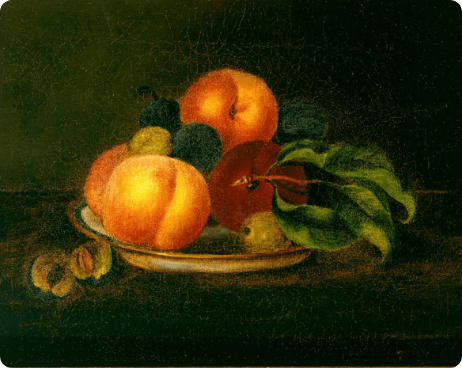
Mary Jane Peale and her father, Rubens Peale, worked closely in the last years of Rubens’ life. There are many instances where the two copied one another’s works and even painted parts of each other’s paintings. Their close artistic relationship was fairly typical of the Peale family. In this still-life, it is thought that Mary Jane’s work is a copy of her father’s work, which was most likely a copy of a work by Margaretta Angelica Peale, who was Rubens’ cousin. Works like this from the Peale family are emblematic of their artistic and familial bonds.
FOR FURTHER THINKING: Works by various Peale family members were often claimed by only one artist, despite having been a collaborative effort.
What do you think this says about their family and how they viewed artistry?
Would you agree to let a family member claim authorship of something if you had helped create it?
STILL LIFE WITH PEACHES AND PLUMS
MARY JANE PEALE (1827-1902)
PHILADELPHIA, 1810–20
1892
OIL ON CANVAS

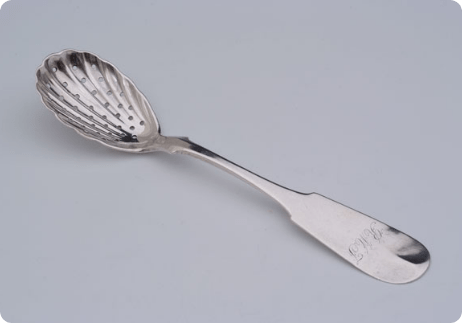
This condiment spoon was created by Hannah Robinson, one of the only female silversmiths in Delaware in the 19th century. Robinson created her products and managed her business on Market Street in Wilmington. Many of her pieces bear the stamp “H. Robinson” on the reverse and feature delicate floral designs and engravings of the owners’ initials.
FOR FURTHER THINKING: Why might people from the 19th century have considered silversmithing more appropriate work for men than for women? What challenges or advantages might a woman silversmith have had in that period?
CONDIMENT SPOON
HANNAH ROBINSON (1803-1878)
CA. 1850


The existence of sunglasses is often thought to date back as far as the Roman Empire, during which time Pliny the Elder gave an account of Emperor Nero watching sporting events through tinted glasses. References continue in sources throughout history and there were several made for Civil War soldiers. Although there may have been some large production of sunglasses during the period in which this pair was made, these spectacles were probably more specifically crafted.
FOR FURTHER THINKING: Sunglasses are one of myriad ways humans have adapted to challenges presented by nature. What are some other inventions we’ve created to protect us from the elements?
SPECTACLES
EITHER JACOB F. (1819-1867) OR
JOHN F. (1812- 1867) ROBINSON
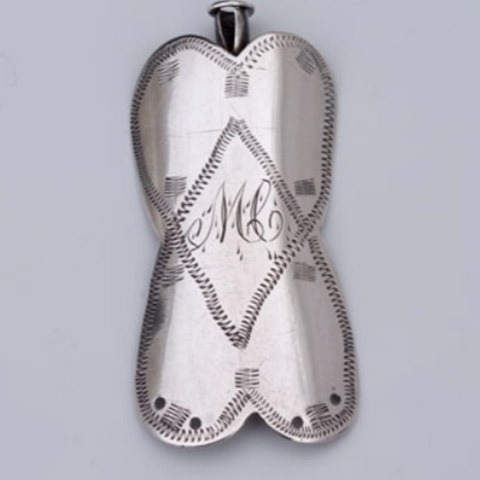
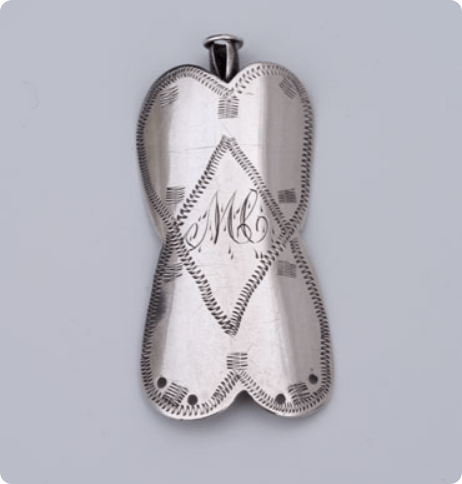
Until the modern era, needles were a commodity and it would have been important to keep track of them. Needle holders offered people the chance to safely store their needles in an aesthetically pleasing case. This particular object is 1 ½ inches long and could have held a few small sewing needles.
FOR FURTHER THINKING: Often historians uncover objects whose utilitarian purpose is unclear and they must theorize about their use. If you came across this object with no context, what purpose do you think you might have assigned to it?
NEEDLE HOLDER
JOSEPH DRAPER (1801-1864)
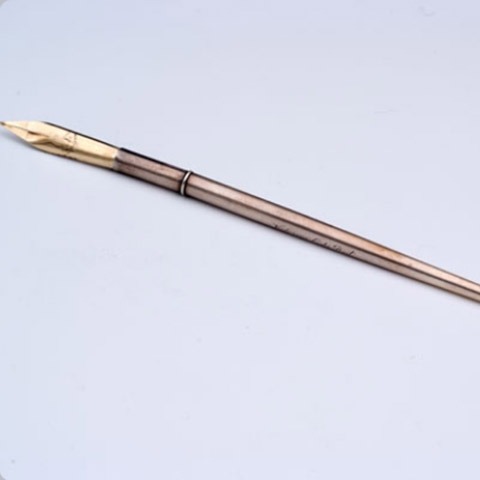
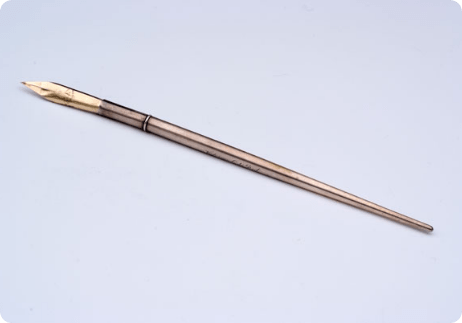
This pen nib and silver pen is engraved “Victorine E. du Pont” and belonged to one of three Victorine Elizabeth du Ponts, who lived between 1792 and 1934. The silversmith, Ziba Ferris, was a favorite among the du Pont family in Wilmington.
FOR FURTHER THINKING: Although pens are easily replaceable and disposable today, during the era when this pen was made, they were unique and often expensive commodities. What special objects do we have in the present that might someday become as ubiquitous as pens are today?

